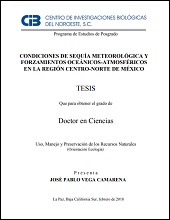Mostrar el registro sencillo del ítem
Condiciones de sequía meteorológica y forzamientos oceánicos-atmosféricos en la región centro-norte de México
| dc.contributor | LUIS BRITO CASTILLO | |
| dc.creator | JOSE PABLO VEGA CAMARENA | |
| dc.date | 2018-02 | |
| dc.identifier | http://cibnor.repositorioinstitucional.mx/jspui/handle/1001/905 | |
| dc.identifier.uri | http://dspace.cibnor.mx:8080/handle/123456789/2367 | |
| dc.description | "En la región del Altiplano Mexicano se encuentran grandes áreas de cultivo y es la principal región de producción de frijol de temporal en México con importancia nacional e internacional en la provisión de alimentos. Esta región es semiárida, por lo que la agricultura de temporal es altamente dependiente a la ocurrencia de las lluvias. Este trabajo tuvo como objetivo estudiar la dinámica del flujo de humedad que es conducido hacia el Altiplano Mexicano desde los mares adyacentes para entender mejor la ocurrencia de sequías sobre esta región y contribuir en la mejora de los pronósticos meteorológicos. Para lograr este objetivo nos enfocamos en atender los siguientes objetivos específicos: 1) Identificar y caracterizar los eventos de sequía; 2) Entender los mecanismos oceánicos y atmosféricos que gobiernan la ocurrencias de sequías; 3) Definir el mecanismo que gobierna el balancín de las lluvias entre la costa de Nayarit y el Altiplano Mexicano y 4) Analizar los patrones de viento superficial al interior de la cuenca del río San Pedro-Mezquital y discutir los resultados de una modelación numérica. Con base en el análisis del Índice Estandarizado de Precipitación, a una escala temporal de 12 meses, se identificó que el episodio seco más severo en el Altiplano Mexicano ocurrió en 2011-2012 y el más persistente en 1998-2001. Notamos que durante ambos episodios las condiciones fueron opuestas en la región de la Costa de Nayarit, otorgando evidencias de la existencia de un balanceo en las lluvias entre ambas regiones (es decir, seco en el Altiplano Mexicano y húmedo en la costa de Nayarit y viceversa). Los resultados mostraron que ambos episodios secos tuvieron lugar cuando la Oscilación Decenal del Pacífico se encontraba en una fase negativa y la Oscilación Multidecenal del Atlántico en una fase positiva, ambos en combinación con el fenómeno de La Niña. El flujo atmosférico en ambos episodios estuvo dominado por una circulación anticiclónica posicionada sobre el continente en la troposfera media con centro en el sur de Estados Unidos y norte de México. Bajo estas condiciones se observa convergencia de humedad en altura sobre el Altiplano Mexicano y divergencia en superficie, que se asocian a subsidencia de aire seco y por lo tanto días sin lluvias en el Altiplano Mexicano..." | |
| dc.description | "In the Mexican Altiplano large dryland farming areas are extensive, and it is the main region of bean production in Mexico, with international significance in terms of domestic and international food supplies. This region is semi-arid and agriculture is highly dependent on the occurrence of rainfall. The goal of this work was to study the dynamics of moisture flow that is conducted towards the Mexican Altiplano from the adjacent seas, to better understand the occurrence of droughts in this region and lead to the improvement of weather forecasting. To achieve this goal, we focused on the following specific objectives: 1) Identify and characterize drought events; 2) Understand the ocean-atmospheric mechanisms that govern the occurrence of droughts; 3) Define the mechanism that governs the seesaw rainfall behavior between the coast and the Mexican Altiplano and 4) Study the surface wind patterns inside the San Pedro-Mezquital river basin, and discussed the results of numerical modeling. Based on the analysis of the Standardized Precipitation Index, at a time scale of 12 months, the most severe dry episode in the Mexican Altiplano was identified in 2011-2012 and the most persistent in 1998-2001. We noted that in both episodes conditions between the coast of Nayarit and the Altiplano were out of phase, providing evidence of the existence of a see saw rainfall behavior between both regions (i.e. dry in the Mexican Altiplano and humid in the coast of Nayarit and vice versa). The results showed that both episodes occurred when the Pacific Decadal Oscillation was in negative phase and the Atlantic Multidecadal Oscillation in positive phase, both in combination with a La Niña event. The atmospheric flow in both episodes was dominated by a middle tropospheric anticyclonic circulation positioned on the continent, centered in the southern United States and northern Mexico. Under these conditions moisture convergence is observed at middle- to upper- levels over the Mexican Altiplano while divergence is observed at the surface, indicating subsidence of dry air, and therefore days with no rainfall in the Mexican Altiplano..." | |
| dc.format | application/pdf | |
| dc.language | spa | |
| dc.publisher | Centro de Investigaciones Biológicas del Noroeste, S.C. | |
| dc.rights | info:eu-repo/semantics/openAccess | |
| dc.rights | http://creativecommons.org/licenses/by-nc-nd/4.0 | |
| dc.subject | info:eu-repo/classification/AUTOR/Sequía, Altiplano Mexicano, Flujo atmosférico, Precipitación | |
| dc.subject | info:eu-repo/classification/AUTOR/Drought, mexican altiplano, atmospheric flow, rainfall | |
| dc.subject | info:eu-repo/classification/cti/1 | |
| dc.subject | info:eu-repo/classification/cti/25 | |
| dc.subject | info:eu-repo/classification/cti/2509 | |
| dc.subject | info:eu-repo/classification/cti/250207 | |
| dc.subject | info:eu-repo/classification/cti/250207 | |
| dc.title | Condiciones de sequía meteorológica y forzamientos oceánicos-atmosféricos en la región centro-norte de México | |
| dc.type | info:eu-repo/semantics/doctoralThesis | |
| dc.type | info:eu-repo/semantics/acceptedVersion |


